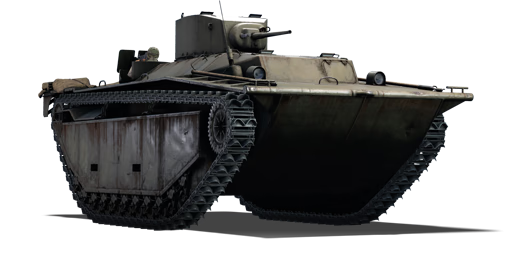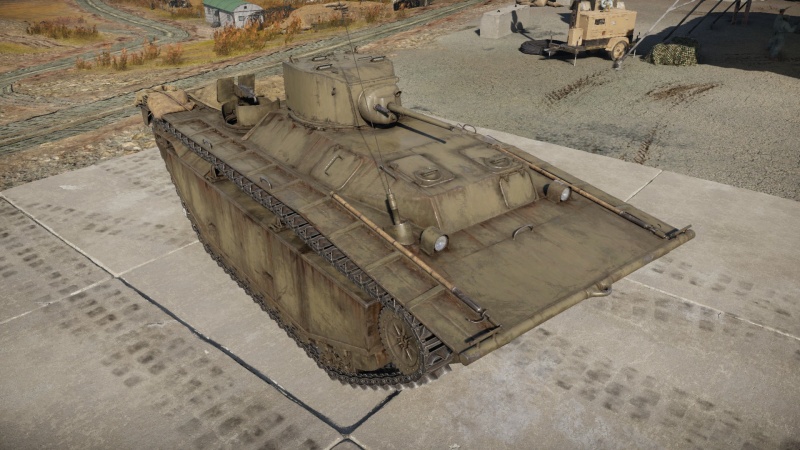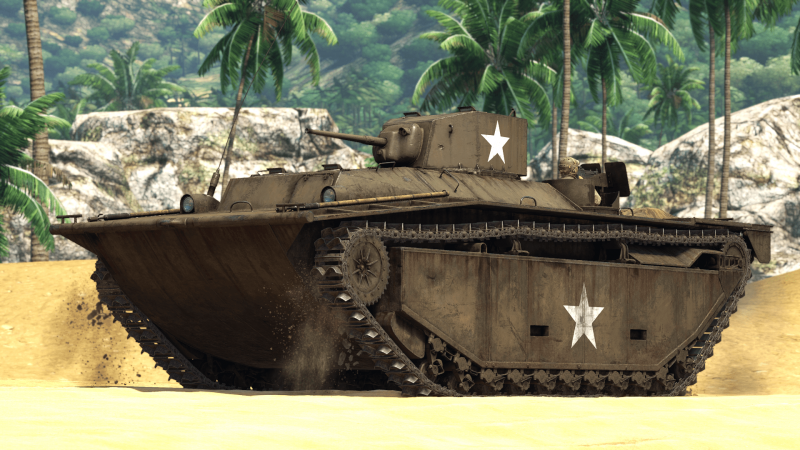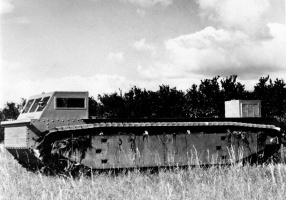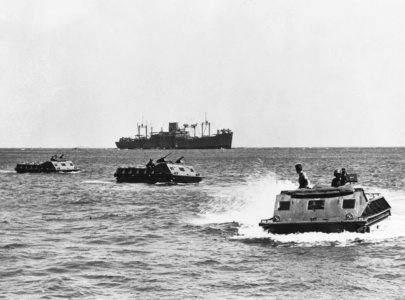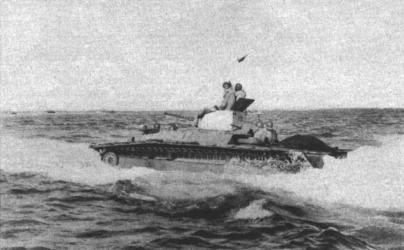LVT(A)(1)
| This page is about the American light tank LVT(A)(1). For other versions, see LVT (Family). |
Contents
Description
The Landing Vehicle Tracked Amoured Mark 1 - LVT(A)(1) is a member of the Amphibious Vehicle, Tracked (LVT) family of amphibious vehicles developed by the U.S. Navy and U.S. Marines. Originally designed and used as cargo ship carriers for ship-to-shore operations to transport personnel and materials, they gradually evolved into amphibious fire support vehicles, as well as other amphibious assault landing variants. The first infantry support LVT(A) version was the LVT(A) Mark 1. With the first combat experience of Pacific amphibious operations for the U.S. Navy and U.S. Marines, it was evident that more firepower than the M1917 Browning heavy machine gun commonly utilized by the U.S. Marines was required. It had a turret similar to the Light Tank M3 (M3 Stuart) – a 37 mm Gun M6 on an M44 mount and a coaxial M1919A4 light machine gun, with two extra M1919A4 light machine guns mounted on ring mounts on the aft deck behind the turret. A vertical stabilizer was integrated into the main gun mount to allow the LVT(A)s to engage enemy positions while still moving in the water. Throughout the war, a total of 509 units were produced. These vehicles were intended to provide direct fire support to attacking Marines as they established a beachhead against their adversaries' defences.
Introduced in the Update "Flaming Arrows", The LVT(A)(1) is a beginner light tank under the U.S. Army ground forces. It has similar firepower to the M3 Stuart but has the unique ability to traverse across water, which other tanks do not have. To keep afloat in the water, the tank is made of relatively thin steel plates and provides little protection against anything heavier than light machine gun fire. Nonetheless, it provides a completely different experience and viable techniques in the accumulation of light tanks in the U.S. Army ground forces that inexperienced players can easily explore.
General info
Survivability and armour
Its large and spacious hull might seem hard to knock out all of its crew, but that's only true when you are getting shot from the side. From your side, there is a huge empty area between the driving compartment and the fighting compartment that will absorb any shell, regardless of their explosive fillers. However an experienced player will know to shoot at these two compartments and avoid the empty space. From the front, the spacious hull does not help to keep the crew safe as a penetrating shell will travel through the empty space and hit any crew at the back, so you could die sooner than you expected. Avoid tanks with solid shots, for example British/Swedish tanks. The deadliest threats are HMG and autocannon mounted vehicles such as the Pz.IIs, T-60, and AA guns. They can quickly chew through all of the crew.
Armour type:
- Rolled homogeneous armour
- Cast homogeneous armour (Gun mantlet, Machine gun shield)
| Armour | Front (Slope angle°) | Sides | Rear | Roof |
|---|---|---|---|---|
| Hull | 12.7 mm (30°) Front plate 6.35 mm (83-84°) Upper glacis 6.35 mm (41-81°) Lower glacis |
6.35 mm (11-51°) Top 6.35 + 6.35 mm Bottom |
6.35 mm Top 6.35 mm (62°) Bottom |
6.35 mm (7°) Front glacis 6.35 mm 5 mm Engine vent |
| Turret | 12.7 mm (10°) Turret front 50.8 mm (1-81°) Gun mantlet |
12.7 mm | 12.7 mm | 6 mm (16°) Front 6 mm Rear |
Notes:
- Suspension wheels and tracks are 15 mm thick.
- Belly armour is 6.35 mm thick.
Mobility
| Game Mode | Max Speed (km/h) | Weight (tons) | Engine power (horsepower) | Power-to-weight ratio (hp/ton) | |||
|---|---|---|---|---|---|---|---|
| Forward | Reverse | Stock | Upgraded | Stock | Upgraded | ||
| Arcade | 45 | 6 | 14.9 | 387 | 477 | 25.97 | 32.01 |
| Realistic | 40 | 5 | 221 | 250 | 14.83 | 16.78 | |
The LVT's mobility is adequate. On hard surfaces it easily reaches its top speed of around 38 km/h. On soft surfaces it needs more time to accelerate, and the top speed is lowered. The reverse speed is extremely poor, which can cause you to take unnecessary hits. The hull traverse is great, allowing you to quickly change direction, however a downside is that when you turn the hull to aim, you might over-turn and swing the gun past the target, increasing the aiming time which can be fatal.
Due to its big and tall tracks, the LVT can drive over some obstacles that are too tall for normal-sized tanks.
Modifications and economy
Armaments
Main armament
| 37 mm M6 | Turret rotation speed (°/s) | Reloading rate (seconds) | |||||||||||
|---|---|---|---|---|---|---|---|---|---|---|---|---|---|
| Mode | Capacity | Vertical | Horizontal | Stabilizer | Stock | Upgraded | Full | Expert | Aced | Stock | Full | Expert | Aced |
| Arcade | 104 | -10°/+25° | ±180° | Vertical | 22.85 | 31.62 | 38.40 | 42.50 | 45.18 | 3.77 | 3.33 | 3.07 | 2.90 |
| Realistic | 14.28 | 16.80 | 20.40 | 22.60 | 24.00 | ||||||||
Ammunition
| Penetration statistics | |||||||
|---|---|---|---|---|---|---|---|
| Ammunition | Type of warhead |
Penetration @ 0° Angle of Attack (mm) | |||||
| 10 m | 100 m | 500 m | 1,000 m | 1,500 m | 2,000 m | ||
| M74B1 | AP | 79 | 76 | 65 | 54 | 45 | 37 |
| M51B1 | APCBC | 87 | 84 | 73 | 60 | 50 | 41 |
| Shell details | ||||||||||||
|---|---|---|---|---|---|---|---|---|---|---|---|---|
| Ammunition | Type of warhead |
Velocity (m/s) |
Projectile mass (kg) |
Fuse delay (m) |
Fuse sensitivity (mm) |
Explosive mass (TNT equivalent) (g) |
Ricochet | |||||
| 0% | 50% | 100% | ||||||||||
| M74B1 | AP | 883 | 0.87 | - | - | - | 47° | 60° | 65° | |||
| M51B1 | APCBC | 883 | 0.87 | - | - | - | 48° | 63° | 71° | |||
Ammo racks
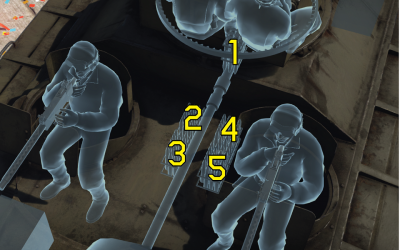
| Full ammo |
1st rack empty |
2nd rack empty |
3rd rack empty |
4th rack empty |
5th rack empty |
Visual discrepancy |
|---|---|---|---|---|---|---|
| 104 | 92 (+12) | 69 (+35) | 46 (+58) | 23 (+81) | 1 (+103) | No |
Machine guns
| 7.62 mm M1919A4 | ||||
|---|---|---|---|---|
| Mount | Capacity (Belt) | Fire rate | Vertical | Horizontal |
| Rear-facing | 3,000 (250) | 500 | -10°/+40° | ±60° |
| Rear-facing | 3,000 (250) | 500 | -10°/+40° | ±60° |
| Coaxial | 3,000 (250) | 500 | N/A | N/A |
The M1919 machine guns are mostly an afterthought on the LVT. The rear machine gunners are exposed to bullets and are most likely the first knocked out in engagements. The bullets are only useful against some light tanks and open-topped vehicles. The LVT can double as an anti-aircraft platform as well, because the elevation on the coaxial and rear machine guns is better suited for this task.
Usage in battles
Use the LVT(A)(1)'s ability to sneak up waterways to work around the enemy lines, and ambush when possible. If that is not a option, come at them head on, either taking their vehicle out or disabling it long enough to get around and finish it with a side shot. Once done, do not take the waterways back as the LVT(A)(1) is much faster on land.
This tank has the capability to work as an early assault tank, not as fast as the Stuarts, BTs and other light tanks.
Another tactic that can be done against lightly armoured vehicles is to drive backwards towards the enemy. The combined firepower of 3 machine guns and the cannon increases the chance of take out the enemy before they can take out the LVT(A)(1).
The big thing to keep in mind is that the LVT(A)(1) is big. It is a large target that is hard to hide, but the spacious interior makes it harder for enemies to take out all of the crew members.
At the same time, keep in mind that the LVT(A)(1) is an easy target for aircraft, as the vehicle presents as very easy target for anything .50 cal and up.
Pros and cons
Pros:
- Very fast and manoeuverable on most terrain
- 6 crew members
- Fast-firing and accurate 37 mm gun
- Crew members are spread out, less likely to get knocked out in one shot
- Great gun depression at the side and front
- Heavily armoured gun mantlet
- 2 machine gunners that can fire at high angles, enabling anti-air
- Small engine makes it hard to hit
- Reserve tank (no repair costs)
- Amphibious (the first reserve floating tank)
- Most of the interior is empty space meaning that most tanks will need a few shots to knock out this tank
Cons:
- Huge (shell magnet)
- Barely any armour to speak about
- Exposed lower glacis
- Weak armour and huge size makes it vulnerable to artillery
- Can easily be destroyed by HE shells (overpressure).
- Very slow reverse speed can prevent it from retreating back to cover in time
- Unstable aim while moving
- Bad suspension makes it unstable at humps
- Very slow speed when traveling in water
- Water rocks the tank when moving, making it unstable during and a while after movement in the water
- Poor Gun Depression in the rear in combination with it´s size makes it hard to hit smaller tanks who attack from the rear
History
Development
The vehicle's origins is from a swamp-access vehicle called the "Alligator" made for civilians. Donald Roebling, its developer, built an improved version of his vehicle with better speed in water. The United States Marine Corps became interested in this amphibious design as they began drawing up their amphibious warfare doctrine. They requested a more sea-worthy version of the vehicle for use in their military operations. Though Roebling and the Navy were reclusive on that idea (the Navy believes they have the current vehicle in store already), the idea brought fruit when World War II broke out in Europe and Roebling created a military version. After a few trials with improvements like a stronger engine, the Bureau of Ships placed a contract for 100 of these vehicles with all-steel armour. The first ones arrive in July 1941, with 200 more ordered before the initial contract was finished. The vehicle design was adopted and designated the LVT, with many different variants of the vehicle being produced throughout the war.
Variants
The first version of the LVT, the LVT-1, could carry 18 men or 4,500 pounds of equipment. The Marines first used the LVT-1 in Guadalcanal with 128 available to 1st Marine Division. Usage in the field revealed that the LVT was too thinly armoured for a rapid deployment back and forth the ships and landing site, but the Marines saw the vehicle's potential as an assault vehicle. So in June 1941, the Marines push forward with a Roebling design of the LVT armed with a gun turret. In order for this to be possible, the LVT underwent a redesign into the LVT-2 "Buffalo", which had a new powertrain and suspension to allow better performances on land and able to carry up to 6,950 pounds in equipment. It was this design that the turret-equipped LVTs were created. The LVT-2s were armed with turrets from the Stuart series and M8 howitzer motor carriages. These two turret variants are designated LVT(A)-1 and LVT(A)-4 respectively. The (A) standing for "armoured" as the LVT was built with additional armour to withstand small arms fire. 510 of the LVT(A)-1 were created while 1,890 of the LVT(A)-4 were created.
Other variants of the LVT were produced featuring redesigns for its purpose of infantry fire support and cargo-bearing. Some of the significant ones was the LVT-4 in August 1943 that moved the engine forward and had a rear ramp door, which increased capacity from 18 soldiers to 30, making previous load-carrying LVTs obsolete. The LVT-4 was the most numerous of the LVT variants at 8,351 units.
Combat usage
The first usage of the LVT family is as a cargo carrier in Guadalcanal, it was unarmoured at the time and only had machine guns as their main armaments. Their next usage was in Tarawa, which saw the first usage of the newly designed LVT-2. The vehicles in both cases carried ammunition, troops, and wounded back and forth the ships and the beach. After Tarawa, the LVT inventory increased by the battalion, as well as the appearance of the gun-armed LVT(A)-1 and LVT(A)-4. The LVT family continued to see service in Bougainville, the Marshall Islands, Saipan, Peleliu, Leyte (its largest usage in the war), Iwo Jima, and Okinawa. The LVTs also saw use in South East Asia in use by the British, but they never saw combat action.
Outside the Pacific, the LVT also saw use in the European Theater of Operations. Their first usage was in North Africa in November 1942 during Operation Torch to land troops, where its best usage was to get stranded landing boats back into action. The LVTs were also given to the British as part of Lend-Lease. The LVTs were used in the Normandy landings and other operations in Europe such as crossing the Rhine River in Germany and Po River in Italy.
After World War II, the LVTs continued to see action in the multiple conflicts in the world. A number were given to the Chinese Nationalists in the Chinese Civil War by America. Many of these were captured by the Chinese PLA, with some converted to use a 75 mm howitzer or a ZIS-2 anti-tank gun. The Americans used a number of LVT vehicles in the Korean War, notably the landing at Inchon and the attack on Seoul. The French also used American-supplied LVTs during the Indochina War and the Suez Crisis.
Media
- Skins
- Videos
See also
- Other vehicles of similar configuration and role
External links
| Food Machinery Corporation (FMC) | |
|---|---|
| Amphibious AFVs | LVT(A)(1) · LVT(A)(4) |
| IFVs | M3 Bradley · M3A3 Bradley |
| USA light tanks | |
|---|---|
| LVT | LVT(A)(1) · ○LVT(A)(1) · LVT(A)(4) |
| M2 | M2A2 · M2A4 · M2A4 (1st Arm.Div.) |
| M3/M5 Stuart | M3 Stuart · M3A1 Stuart · M3A1 (USMC) · M5A1 · M5A1 TD · ▃Stuart VI (5th CAD) |
| M22 Locust | M22 |
| M24 Chaffee | M24 · M24 (TL) |
| M18 Hellcat | M18 GMC · M18 "Black Cat" · Super Hellcat |
| M41 Walker Bulldog | M41A1 |
| M551 Sheridan | M551 · M551(76) |
| M3 Bradley | M3 Bradley · M3A3 Bradley |
| Wheeled | M8 LAC · T18E2 · M1128 · M1128 Wolfpack |
| Other | M8A1 GMC · T92 · T114 · HSTV-L · CCVL · XM8 · XM800T · AGS |


